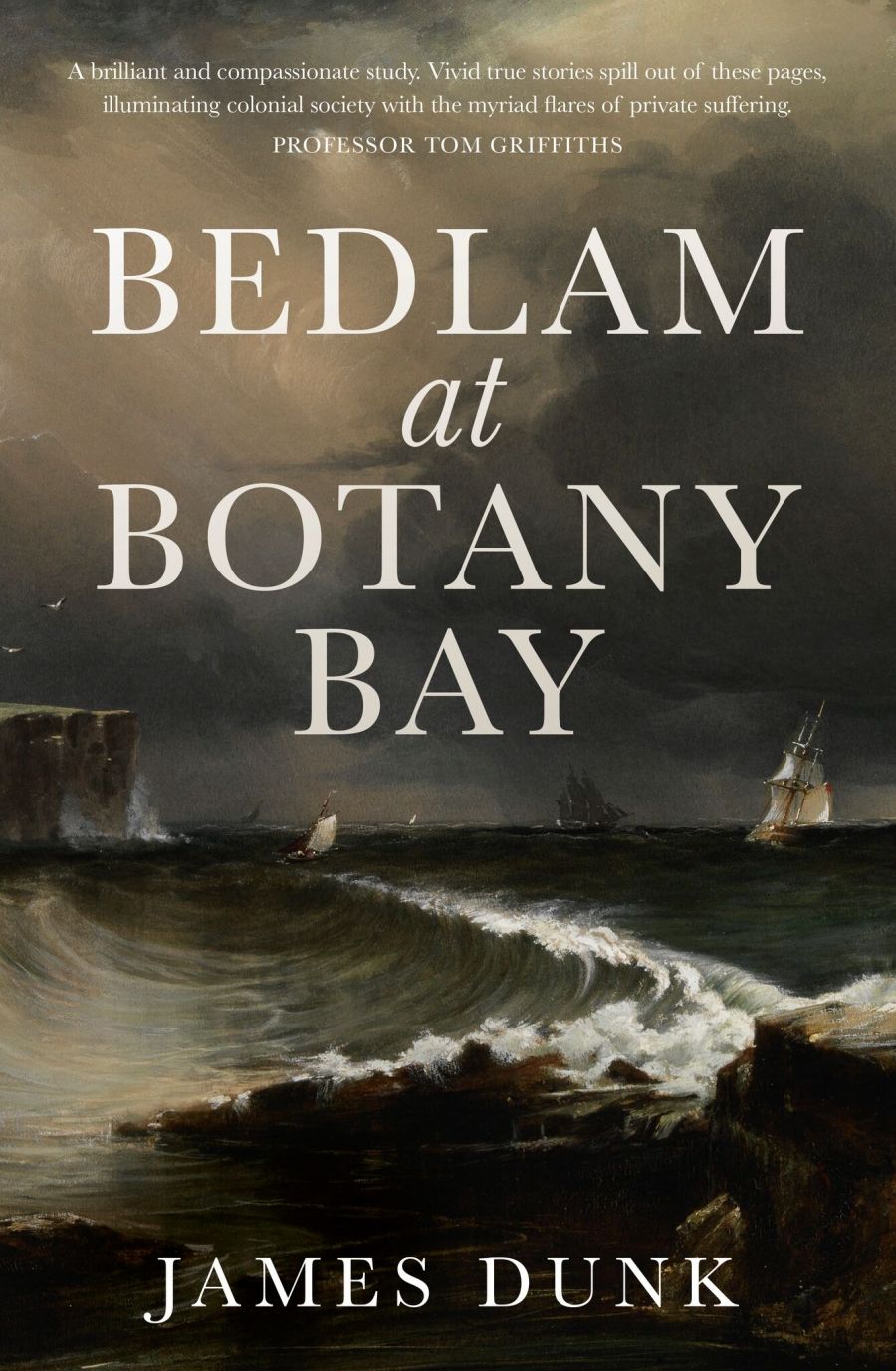
- Free Article: No
- Contents Category: History
- Custom Article Title: Alan Atkinson reviews <em>Bedlam at Botany Bay</em> by James Dunk
- Custom Highlight Text:
James Dunk is not the first Australian historian to notice that mental breakdown was surprisingly common during the first two European generations in New South Wales. Malcolm Ellis linked the ‘Botany Bay disease’ to rheumatic fever, rife on shipboard, which ‘ruined the lives or unbalanced the minds of … many pioneers’. Manning Clark spoke of ...
- Book 1 Title: Bedlam at Botany Bay
- Book 1 Biblio: NewSouth, $34.99 pb, 512 pp, 9781742236179
Alternately, a strong hand can sometimes be the only way of dealing effectively with mental disability. Dunk pursues both lines of causation, power producing madness and madness shaping power. He suggests that conditions in early colonial New South Wales were at least one reason why, in some cases, individuals suffered mental impairment, although he admits that inborn susceptibility might have got them there in the first place. Convicts were not just ratbags or rebels, or men and women driven to crime by poverty. In some there was mental weakness, such as exists now in prisons everywhere.
Focusing on ‘Bedlam’ itself, Dunk is mainly interested in the use and misuse of power as a concomitant of madness. Maybe he could have looked more closely at the interaction of susceptibility and circumstances. Even in twenty-first-century clinical work, he might find it hard to know which matters more as a causal factor and whether they can ever be fully separated. But the records for this early period are scanty. Only later in the nineteenth century did a full-blown bureaucracy emerge from the government’s management of mental disability. Dunk’s argument therefore rides on anecdote. Spectacular cases drew remark, and sometimes the disabled were so violent and/or helpless that the authorities had to step in. He draws the various stories together with real skill.
Medical professionals were beginning to be interested in causes and possible cures for madness, but otherwise these records mainly bear on questions of power and freedom, questions that became especially urgent when restraint seemed to involve cruelty and trust arrangements led to theft and waste.
By this time, the old understanding of freeborn Britons managing their own lives and property was overlaid with Enlightenment notions of interiority. What was mind? What was personal identity and consciousness? What happened to personhood when individuals came adrift even from the common-sense understanding of such things? Kirsten McKenzie’s work (Scandal in the Colonies [2004] and A Swindler’s Progress [2009]) has shown how they could seem especially uncertain in the outposts of empire, away from the centralised accountability that grounded Britons’ sense of who they were. The unfamiliar, even experimental, forms of authority in New South Wales were especially disorienting.
 Botany Bay, 1789, watercolour by Charles Gore (photograph via Wikimedia Commons/NSW State Library)
Botany Bay, 1789, watercolour by Charles Gore (photograph via Wikimedia Commons/NSW State Library)
In Bedlam at Botany Bay, the focus on madness, individual liberty, restraint, and authoritarianism is therefore very apt. It involves also the question of the governor’s delegated power and his delegation of power. It involves conflicts between governing authority and medical judgement, another reminder of Nauru and Manus Island, except that in early New South Wales medical men could be tyrannical too. Dunk quotes a doctor telling his patient, ‘If I say you are mad today, you are mad, and if I say you shall be well tomorrow, you shall be well, and if I order you to walk upon your head, you shall walk upon it.’
The book’s unfolding logic is unusual, running at last into far-reaching and difficult speculation. The first six chapters tell of a growing complexity over time, from 1788 to the 1830s. Then in chapter seven we go back almost to the beginning to hear the life story of John Macarthur, which by Dunk’s account was threaded through with anxiety and despair, ending in madness, and only in chapter eight are we are given the end of the larger narrative. At this final point, in the 1840s, the big issues – government versus medical expertise, arbitrary power, institutional confinement – take new forms, thanks to better organised politics and better articulated public opinion.
But then there is Dunk’s epilogue, where long-term anxiety and despair appear as something embedded within the settlement as a whole, and from the start. ‘Madness,’ he writes, ‘wreaked havoc on the inchoate structures of government.’ More than that, madness was connected somehow with the violence of invasion, because of the way that violence must have ‘wounded’ its perpetrators. So madness belongs to our larger, long-term inheritance. All this needs more careful explanation and another book. So far it works only as a large hypothesis.
Historians of early European settlement usually belong to one of two schools, Order or Disorder. The School of Order dwells on the intricacies of habit, custom, and law. Henry Reynolds, for instance, although he chronicled murder and dispossession, is ultimately a denizen of Order. He seems to assume that there was always a better way forward. The School of Disorder makes its contribution by shining light into the darker places of humanity. This book carries the stamp of Disorder. As James Dunk says, whatever theorists and administrators might think, in the minds of the powerless the project of settlement was chaotic. For some, the chaos was too hard to bear.


Comments powered by CComment